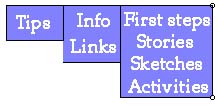
|
|
On this page we have gathered resources and links that will be specially helpful for beginning SketchMad
teachers. If you would like to learn how to become a more proficient Sketchpad user before trying activities with your students, you
could follow this Introductory Sketchpad
Lab
or Getting started with Sketchpad.
Some teachers have also found following the Workshop Guide very helpful; you can download it from the Key Curriculum press
website here. You might also try some of the
activities from the modules that come with the Ontario License CD-ROM: Exploring Geometry and
Geometry Activities for Middle School. You should have access to them at school,
and you can also download the supporting sketches and
scripts
from the Spectrum website here.
You might also want to begin by reading the Stories from the Classroom for ideas on how Sketchpad can be used in the classroom. These stories exemplify only one of the many possible ways of using Sketchpad to help enhance your students' learning. Many teachers prefer using Sketchpad as a demonstration tool within their own classrooms using only one computer and a projection device. Your students will learn a great deal about Sketchpad just by watching you manipulate sketches--this may help the transition to the computer lab. There are a wide range of Sample sketches available on this site that work well for demonstrations of concepts such as tangents, conic sections and trigonometric functions. You might find these posters of Sketchpad hints for constructions, measurements, and tranformations helpful. Just print them up and post them on your classroom walls. You might also find these Primers helpful: Depending on the grade level you are teaching, you can select from some activities and lesson plans on this site. There are also some great activities in both the modules included in the Ontario Sketchpad CD-ROM: Exploring Geometry and Geometry Activities for Middle School. Here are a few other suggestions for activities to start with (not all on this site) for each grade:
|